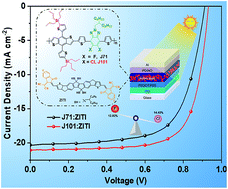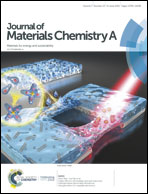A wide-bandgap D–A copolymer donor based on a chlorine substituted acceptor unit for high performance polymer solar cells†
Abstract
Realizing the triple functions of simultaneously improved open circuit voltage (Voc), short circuit current density (Jsc) and fill factor (FF) enabled by material design is a vital challenge for achieving efficient and stable polymer solar cells (PSCs). Herein, we developed a new wide-bandgap donor–acceptor (D–A) copolymer, J101, with a down-shifted highest occupied molecular orbital (HOMO) level by chlorine substitution on its 2-alkyl-benzo[d][1,2,3]triazole (BTz) unit. The PSCs fabricated by combining the J101 donor with the indenoindene-containing fused-ring electron acceptor ZITI demonstrated a remarkable power conversion efficiency (PCE) of 14.43% with a high Voc of 0.937 V, a high Jsc of 21.25 mA cm−2 and a high FF of 72.48%, benefitting from the low HOMO level of the donor, suitable nanoscale morphology, efficient charge transport properties and reduced recombination losses. Furthermore, semitransparent PSCs based on the optimized J101:ZITI blend exhibited the best PCE of 11.04% with an average visible transmittance (AVT) of 21.69%. This work demonstrates that the chlorine substituted BTz unit is an excellent electron-accepting building block for high-performance opaque and semitransparent PSCs.



 Please wait while we load your content...
Please wait while we load your content...